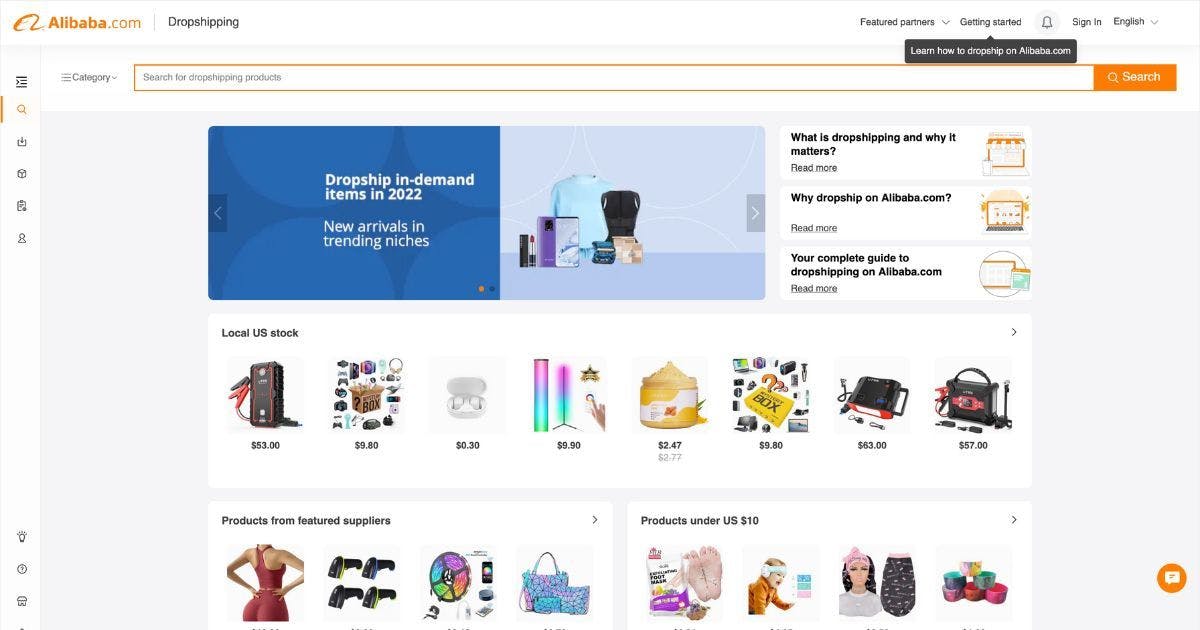7 Best Practices for Dropshipping Inventory Management

By Pritesh B
Posted | 10 min read
Table of contents
- Dropship Inventory Management Best Practices
- Research and choose reliable suppliers
- Keep track of inventory levels
- Use automation tools
- Optimize your shipping strategy
- Implement a return policy
- Use data analytics
- Review and update your inventory management process
- Challenges and Solutions while Managing Inventory
- Benefits of Dropshipping
- Storeplum and Dropshipping
- FAQs
Dropshipping is a great retail business model for online retailers as you can start one without the need for a physical inventory.
Drop ship allows you to operate your business from anywhere, dropshipping allows you to not only run your business from the comfort of your home but also with an ease as it can be easily automated. It is one of the top ecommerce businesses to begin with.
However, managing inventory can be a daunting task if not handled properly. Efficient dropshipping inventory management can make all the difference in the success of your business.
Dropship Inventory Management Best Practices
Similar to affiliate marketing, Dropshipping is an order fulfillment method where a store doesn't keep the products it sells in stock. Instead, when a store sells a product, it purchases the item from a third-party and has it shipped directly to the customer.
As a result, the merchant never sees or handles the product. When a customer orders something, that information is directly sent to the supplier who further ships out the product from the warehouse to the buyer, making it a supply chain. This conclusively means that the seller purchases inventory as needed and pays no such inventory costs.
As a business owner the last thing you want is to have a mess up in the inventory and orders which can occur in a dropshipping model. In this article, we will discuss the most efficient practices for dropship inventory management and how you can optimise your workflow.
We will cover the basics of inventory-management, the challenges of that are faced in the same, how to overcome them as well as the benefits of having a dropshipping business model.
Such a management is the process of managing a business's inventory, including ordering, storing, and tracking inventory levels. Effective management ensures that the right products are available at the right time and in the right quantities in your online store.
This type of management can be challenging because the merchant doesn't physically have the products they sell. It's essential to have a solid systemic in place to ensure the correct products are always in stock and to prevent overselling.
As a dropshipper, managing inventory can be a challenging task. You don't have physical control over your products, and you rely on your suppliers to ship the products directly to your customers.
However, by following some most effective practices for management of your inventory, you can optimise your workflow and improve your overall efficiency. Below we’ll discuss some ways to streamline management for your available inventory, which will help save a lot of time.
1. Research and choose reliable suppliers
The success of your drop-ship business depends heavily on the reliability of your suppliers. Therefore, it is important to research and choose suppliers that you can trust. Look for a dropshipping supplier that has a good reputation, is reliable, and has a history of timely and accurate deliveries.
The relationship with your suppliers and the supply chain management will play a crucial role in this form of business. You need a dropshipping partner that not only offers dropshipping services, other services you need and also ships orders with ease and on time. You can use online dropship platforms such as AliExpress, Oberlo, and SaleHoo to find and connect with a reliable wholesaler.
2. Keep track of inventory levels
In such a type of business, you don’t need to store and ship your products but this means you don’t have a real-time inventory tracking at all times. To avoid running out of stock or overselling, it is crucial to keep track of your inventory levels.
Use a management system to monitor your stock levels in real-time. This will enable you to know when to reorder products and avoid stockouts. Many e-commerce platforms such as Storeplum, Shopify and WooCommerce have built-in management systems for much inventory of products that you can use.
3. Use automation tools
Dropshipping automation tools can help you streamline your dropshipping work / management process. For instance, you can use automated tools to place orders, track orders, and update inventory levels.
This will save you time and reduce the likelihood of errors. Some popular automation tools include Oberlo, DSers, and Ecomdash. Many dropshipping companies use these to automate their overall procedure.
With these tools you can access management solutions like automate order splitting, have real-time inventory/ inventory held by the supplier, which will further make your dropshipping process smooth.
4. Optimize your shipping strategy
Shipping can be a significant cost for retailers, and it can also affect your management of inventory.
Therefore, it is essential to optimise your shipping strategy to minimise costs and improve efficiency. Dropshipping may be successful if you consider factors such as shipping time, shipping costs, and shipping providers.
You can also use shipping calculators to estimate the shipping costs and delivery times for your customers to provide the best dropshipping services.
5. Implement a return policy
Returns are an inevitable part of the e-commerce business, and they can affect your management even when it wasn’t your fault.
It is important to offer your customers a clear and concise returns policy that specifies the conditions for accepting returns.
This will help you manage your inventory more effectively by reducing the likelihood of returns and ensuring that you have a clear process for handling returns and result in profitable dropshipping.
6. Use data analytics
Data analytics can help you identify trends and patterns in your sales and inventory data.
This will enable you to make data-driven decisions and optimise your management process. Use data analytics tools such as Google Analytics and Kissmetrics to track your sales, traffic, and customer behaviour everytime customer places an order or visits the site. This will further increase your visibility. Storeplum provides built-in powerful analytics for your online store.
7. Review and update your inventory management process
Management of overall is not a one-time task; it requires regular review and updates.
Regularly review your management process to identify areas that need improvement and make the necessary changes. For instance, you can review your supplier relationships, shipping strategy, customer’s reviews and returns policy to ensure that they are still effective.
Drop-ship business model has become a popular e-commerce business model due to its ease of entry and low start-up costs. However, while launching a new store managing inventory can be a challenge for retailers as they rely on suppliers to fulfill orders.
Below we’ll discuss some challenges of managing inventory as well as the solutions to it. So that you can solve problems as soon as they arise but you’ll still need to keep an eye out.
Challenges and Solutions while Managing Inventory
Dependence on Suppliers
The success of a dropship business largely depends on the reliability of suppliers as the products are needed from a third party. Retailers have little control over the inventory levels and shipping times of their multiple suppliers. This can lead to stockouts, delayed order shippings, and unhappy customers.
Solution: Establish relationships with reliable suppliers: retailers should carefully choose their suppliers based on their track record of reliability and customer service. Building strong relationships with suppliers can help to ensure timely delivery of products and reduce the risk of stockouts.
Product Quality Control
Since retailers do not have control over the product inventory, they are unable to verify the quality of the products before they are shipped to customers. This can lead to customer complaints and negative reviews.
Solution: Perform Regular Quality Control Checks: Retailers should periodically order samples of their products to check the quality before they are shipped to customers. They can also request that their suppliers perform quality control checks before shipping products to customers.
Price Fluctuations
The prices of products can change frequently due to market fluctuations, changes in supplier pricing, and other factors. Reatilers who do not monitor these changes may find themselves losing money on products they sell.
Solution: Monitor Prices and Adjust Accordingly: Retailers should regularly monitor the prices of their products and adjust their pricing accordingly. They can use tools such as price tracking software to keep track of price fluctuations and adjust their pricing to maintain profitability.
Order Fulfillment Errors
Due to the high volume of orders that reatilers handle, there is a risk of errors in fulfillment of orders. This can lead to incorrect products being shipped, delayed shipments, and unhappy customers.
Solution: Implement Systematic Order Fulfillment Processes: Retailers should establish a systematic process for fulfillment to minimize errors. This can include using order a software for order management to track orders and shipments, creating standard operating procedures for fulfillment, and training staff on the process.
Shipping Delays
Retailers rely on their suppliers to ship products to customers. Shipping delays can occur due to various factors such as supplier stockouts, natural disasters, and shipping carrier delays. This can lead to unhappy customers and negative reviews.
Solution: Communicate with Customers and Manage Expectations: Retailers should communicate with customers and manage their expectations regarding shipping times. They can also use tools such as order tracking software to keep customers updated on the status of their orders.
Data Management
Retailers need to manage a large volume of data such as product information, pricing, order details, and customer information. This can be overwhelming and time-consuming.
Solution: Use Data Management Tools: Retailers can use data management tools such as inventory management software and customer relationship management software to manage their data efficiently. These tools can help to make processes efficient, reduce errors, and improve efficiency.
Cash Flow Management
Retailers need to manage their cash flow carefully as they need to pay their suppliers before they receive payment from customers. This can lead to cash flow challenges and affect profitability.
Solution: Establish a Cash Flow Management System: Retailers should establish a cash flow management system that takes into account their payment terms with suppliers and customers. This can include setting aside funds for supplier payments, using invoice factoring services to improve cash flow, and negotiating longer payment terms with suppliers.
Benefits of Dropshipping
Dropshipping offers a number of benefits that make it an attractive option for entrepreneurs looking to start an online business. With low startup costs, reduced risk, flexibility, a wide product range, and the potential for scalability, it provides a promising opportunity for those willing to put in the effort and dedication required to succeed in the e-commerce industry. Given below are some of the benefits:
Low Startup Costs
One of the primary benefits is the low startup costs involved. With a traditional retail business, the startup costs can be significant, including inventory costs, rental expenses, and employee wages. In contrast, with this model of business, the retailer does not need to invest in inventory or a physical store. This makes it much easier and less expensive to start an online business.
Reduced Risk
Another benefit is the reduced risk involved. Since the retailer is not required to hold inventory, they don't have to worry about being stuck with unsold products. This means that the risk of losing money due to unsold inventory is significantly reduced.
Flexibility
Drop-ship model of business also offers a high degree of flexibility. Since the retailer does not have to hold inventory, they can easily add or remove products from their website. This allows the retailer to test out different products without having to invest in large amounts of inventory. Additionally, since the retailer doesn't have to worry about shipping products themselves, they can operate from anywhere with an internet connection.
Wide Product Range
Because dropshippers don't need to hold inventory, they have the ability to offer a wide range of products on their website. This means that customers can find a variety of products in one place, making the shopping experience more convenient and increasing the likelihood of making a sale.
Scalability
Finally, it offers the potential for scalability. Since the retailer is not required to hold inventory or manage a physical store, they can easily scale their business as demand grows. This makes it possible to expand the business quickly without having to worry about managing physical space or inventory.
Wrapping it Up
In conclusion, dropshipping management of inventory is a crucial aspect of running a successful business. By implementing the most efficient practices such as regularly tracking inventory levels, forecasting demand, optimising product listings, and partnering with reliable suppliers, can refine their workflow and ensure timely fulfillment of orderd.
In addition to these most effective practices, it's also important for retailers to stay up-to-date with industry trends and innovations, such as automation and AI-powered inventory management tools. By leveraging these technologies, retailers can further optimise their workflow and gain a competitive edge in the crowded e-commerce marketplace.
Ultimately, effective inventory management requires a combination of strategy, discipline, and adaptability. By continually evaluating and refining their processes, dropshippers can ensure they are providing a top-notch customer experience while also maximizing their profits. With these top practices in mind, dropshippers can set themselves up for long-term success in the world of e-commerce.
Storeplum and Dropshipping
Are you tired of struggling to make sales on your drop-ship ecommerce platform? It might be time to consider hiring a professional website developer to give your online store the boost it needs. At Storeplum, we specialize in creating stunning, user-friendly e-commerce websites that can help your business thrive.
From dealing with supplier’s work to product data feed to make dropshipping work and become a successful dropshipping business, it’s already a lot. With Storeplum, you don’t have to deal with the ecommerce platform whether you’re new to it or already a pro. As stated in the above article as well, most of the challenges and problems lie with the ecommerce platform and automating it.
Our team of experts has designed and developed websites for a variety of e-commerce businesses. We understand the importance of having a well-designed website that can capture your target audience's attention and turn visitors into customers.
So begin your drop-ship journey today with Storeplum!
How do you manage inventory for dropshipping?
By definition of dropshipping, you do not have to manage inventory. The supplier manages the inventory. Through dropshipping, you will just market the products on your website and let supplier handle the inventory and fulfillment.
Is it better to hold inventory or dropship?
If you wish to run a business with less operational overhead, then drop ship is the way to go. On the other hand, if you wish to build your own brand, then it makes sense to hold inventory. Be aware that operational expenses and captial expenses are far higher in the latter.
Can you do dropshipping on Amazon?
Yes, Amazon's policy states that Amazon allows a dropshipping supplier if you are the seller on record with your seller identification on invoices, packaging, shipping labels, etc

Ecommerce advocate and Co-founder at Storeplum. I like to write about current trends in ecommerce, best practices and innovative ways on improving online store conversions.








